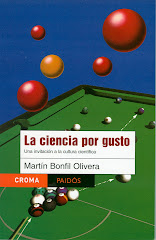Published in Milenio Diario, January 20, 2010
 Math has a special relation with physical reality: it allows us to describe it. This is clearly seen in astronomy: mathematical models, from Ptolemaeus, through Copernicus, up to the glorious Newtonian description and Einstein's modern vision, have allowed us to describe with ever greater precision, and to understand, with great depth, the behavior of celestial bodies. Compared to this, the foolish "predictions" of astrology look like incoherent babble.
Math has a special relation with physical reality: it allows us to describe it. This is clearly seen in astronomy: mathematical models, from Ptolemaeus, through Copernicus, up to the glorious Newtonian description and Einstein's modern vision, have allowed us to describe with ever greater precision, and to understand, with great depth, the behavior of celestial bodies. Compared to this, the foolish "predictions" of astrology look like incoherent babble.What we still do not understand is why math is useful to describe the world. November 2009 edition of the mexican magazine Ciencia y desarrollo (Science and development), where he has written for over 30 years, José de la Herrán, a pioneer in science popularization in Mexico, describes a curious example. It is a study to verify the validity of an old astronomical mystery: the famous, Titius-Bode law.
The law, postulated by German astronomer Johann Daniel Titius in 1776 and popularized by his colleague , fellow German (and namesake!) Johann Elert Bode in 1772, asserts that the distance from the Sun to the planets of the solar system (or, to be more precise, the major semi-axes of their elliptic orbits – the major radii, but the word radius is only used for circles, not for ellipses) seems to be related with a peculiar numerical succession: 0, 3, 6, 12, 24, 48...
Initially, the "law" was not taken seriously: although it was accurate for the then-known planets (Mercury to Saturn), it predicted a non-existent planet in the fifth position, between Mars and Jupiter. But when Uranus was discovered in 1781, and it was confirmed to occupy the spot predicted by it, the law was studied again.
Then, in 1846, Neptune was discovered. Its distance to the Sun did not fit with the prediction (30% error). The same thing happened with Pluto (96% error!). The prestige of this law collapsed, and it was demoted to a mere coincidence.
Here Mexican astronomer Arcadio Poveda, from the Astronomy Institute at UNAM enters the scene. In an article published in 2008 in the Revista Mexicana de Astronomía y Astrofísica (Mexican Astronomy and Astrophysics Journal, in co-authorship with Patricia Lara), he studied 55 Cancri, in the constellation of The Crab, a "nearby" star (about 12 parsecs; more than 40 light years) in whose surroundings, five more planets have been discovered between 1996 and 2007. He found that in general, their distances agree with Titius-Bode law, if it is assumed that there's a missing planet between the fourth and the fifth ones (maybe this would reveal that the gravitational dynamics of emerging planetary systems prevents the formation in certain orbits). Poveda even predicts the position of two planets surrounding 55 Cancri; lets see if these are found.
Although it has been criticised, Poveda's work is very suggestive. The Titius-Bode law is still an enigma: if it were valid, although we still don't know why (epistemologists would say that it is a phenomenological law that lacks its proper theoretical explanation), it could help discover new planets in other planetary systems.
(translated by Adrián Robles Benavides) To receive Science for pleasure weekly
in your email, subscribe here!




No comments:
Post a Comment